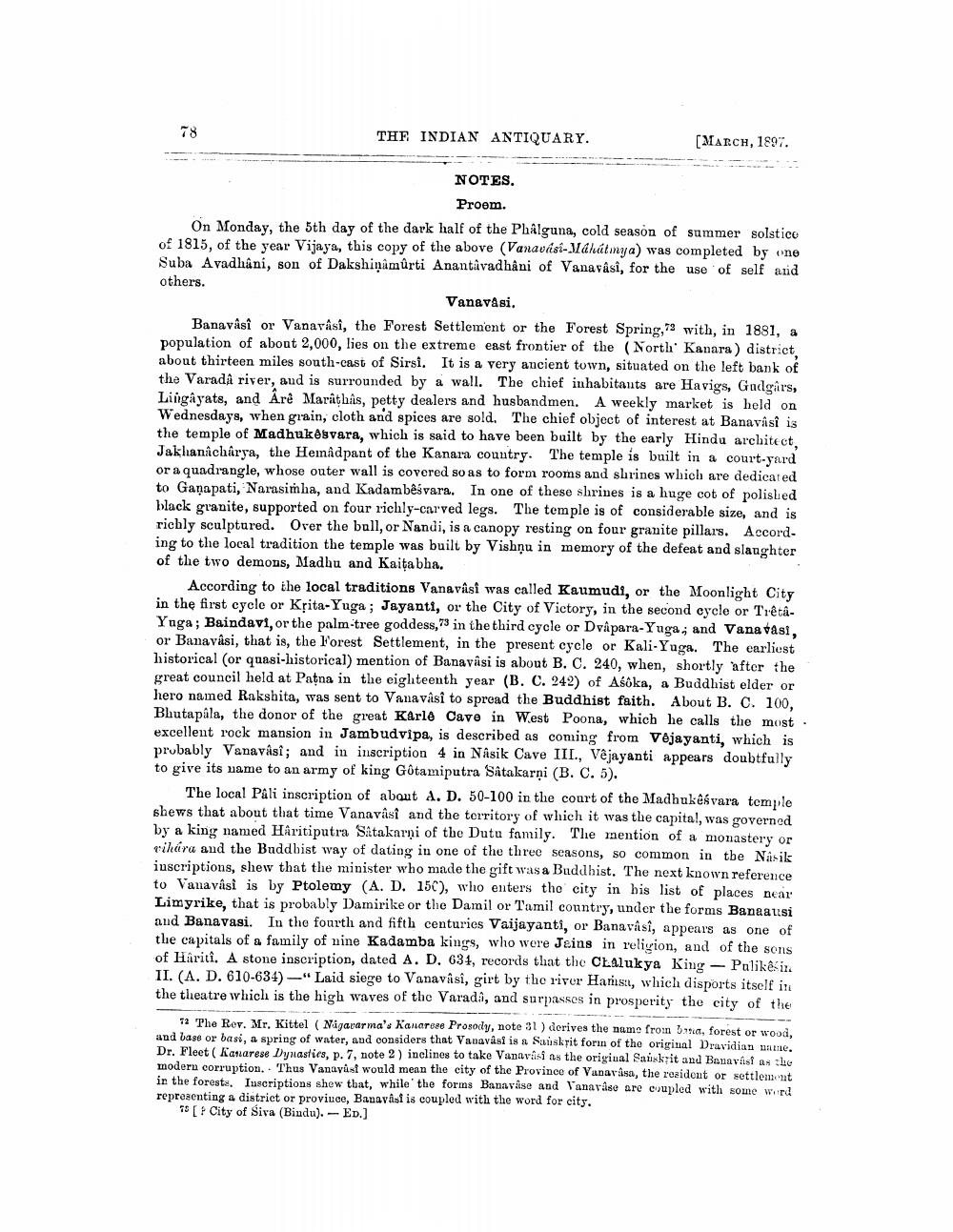________________
THE INDIAN ANTIQUARY.
[MARCH, 1897.
NOTES.
Proem. On Monday, the 5th day of the dark half of the Phålguna, cold season of summer solstico of 1815, of the year Vijaya, this copy of the above (Vanavisi-Jahátmya) was completed by one Suba Avadhâni, son of Dakshiņāmûrti Anantavadhani of Vanavasi, for the use of self and others.
Vanavasi. Banavasi or Vanavâsî, the Forest Settlement or the Forest Spring, 73 with, in 1881, a population of about 2,000, lies on the extreme east frontier of the North Kanara) district about thirteen miles south-cast of Sirsi. It is a very ancient town, situated on the left bank of the Varada river, and is surrounded by a wall. The chief inhabitants are Havigs, Gadgars, Lingayats, and Äré Marathas, petty dealers and husbandmen. A weekly market is held on Wednesdays, when grain, cloth and spices are sold. The chief object of interest at Banavisi is the temple of Madhukesvara, which is said to have been built by the early Hindu architect, Jakhanacharya, the Hemadpant of the Kanara country. The temple is built in a court-yard or a quadrangle, whose outer wall is covered so as to form rooms and shrines which are dedicated to Ganapati, Narasimha, and Kadambêśvara. In one of these shrines is a huge cot of polished black granite, supported on four richly-carved legs. The temple is of considerable size, and is richly sculptured. Over the ball, or Nandi, is a canopy resting on four granite pillars. Accord. ing to the local tradition the temple was built by Vishnu in memory of the defeat and slaughter of the two demons, Madhu and Kaitabha.
According to the local traditions Vanavâsî was called Kaumudi, or the Moonlight City in the first cycle or Krita-Yuga; Jayanti, or the City of Victory, in the second cycle or TrêtaYuga; Baindavi, or the palm-tree goddess,73 in the third cycle or Dvâpara-Yuga, and Vanatasi, or Banavasi, that is, the Forest Settlement, in the present cycle or Kali-Yuga. The earliest historical (or quasi-historical) mention of Banavasi is about B. C. 240, when, shortly after the great council held at Patna in the eighteenth year (B. C. 242) of Asoka, a Buddhist elder or hero named Rakshita, was sent to Vanavasi to spread the Buddhist faith. About B. C. 100, Bhutapala, the donor of the great Karle Cave in West Poona, which he calls the most excellent rock mansion in Jambudvipa, is described as coming from Vejayanti, which is probably Vanavâsî; and in inscription 4 in Nâsik Cave III., Vêjayanti appears doubtfully to give its name to an army of king Götamiputra Satakarņi (B. C. 5).
The local Pali inscription of about a. D. 50-100 in the court of the Madhukeśvara temple shews that about that time Vanavâsî and the territory of which it was the capital, was governed by a king named Haritiputra Satakarni of the Dutu family. The mention of a monastery or vihera and the Buddhist way of dating in one of the three seasons, so common in the Narik inscriptions, shew that the minister who made the gift was a Buddhist. The next known reference to Vanavasi is by Ptolemy (A. D. 15C), who enters the city in his list of places near Limyrike, that is probably Damirike or the Damil or Tamil country, under the forms Banaausi and Banavasi. In the fourth and fifth centuries Vaijayanti, or Banavâsî, appears as one of the capitals of a family of nine Kadamba kings, who were Jains in religion, and of the sons of Hariti. A stone inscription, dated A. D. 634, records that the CLAlukya King - Palikesin. II. (A. D. 610-634) "Laid siege to Vanavasi, girt by the river Hansıt, which disports itself in the theatre which is the high waves of the Varadi, and surpasses in prosperity the city of the
TO The Rev. Mr. Kittel (Nigavarma's Kanarone Prosody, note 31 ) derives the name from bra, forest or wood, and base or basi, a spring of water, and considers that Vanavasi is a Sanskrit forin of the original Dravidian name. Dr. Fleet ( Kanarese Dynastics, p. 7, note 2) inclines to take Vanavasi as the original Sauk it and Bonavast as the modern corruption. Thus Vanayast would mean the city of the Province of Vanavása, the roaident or settlement in the forests. Inscriptions shew that, while the forms Bannvaso and Vanaviso are ovupled with some wird representing a district or proviuce, Banavasi is coupled with the word for city.
55 [ City of Siva (Bindu). -Ed.)




